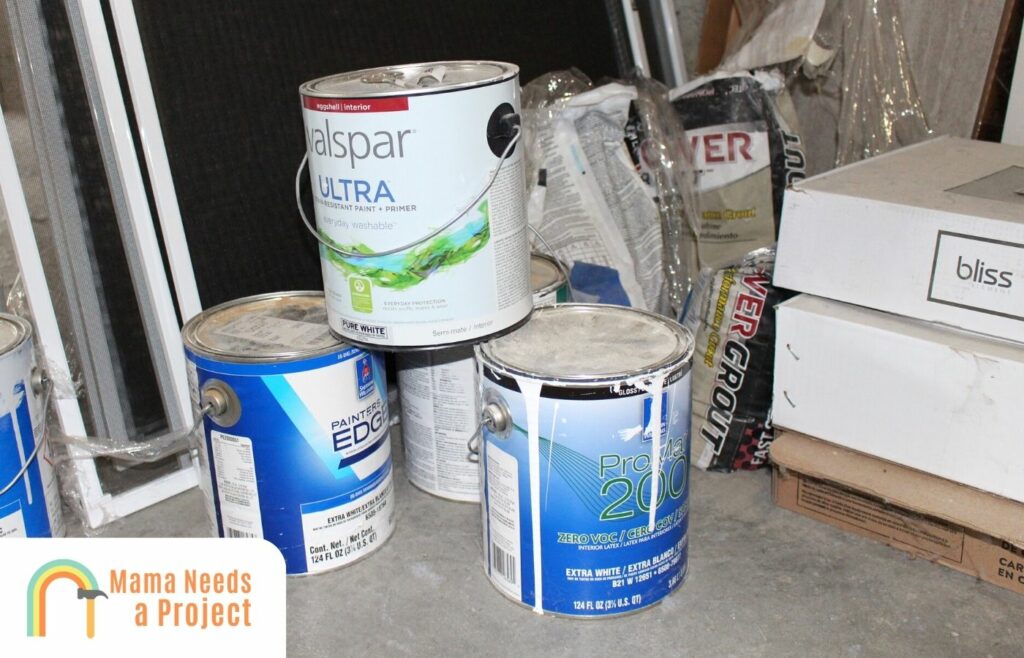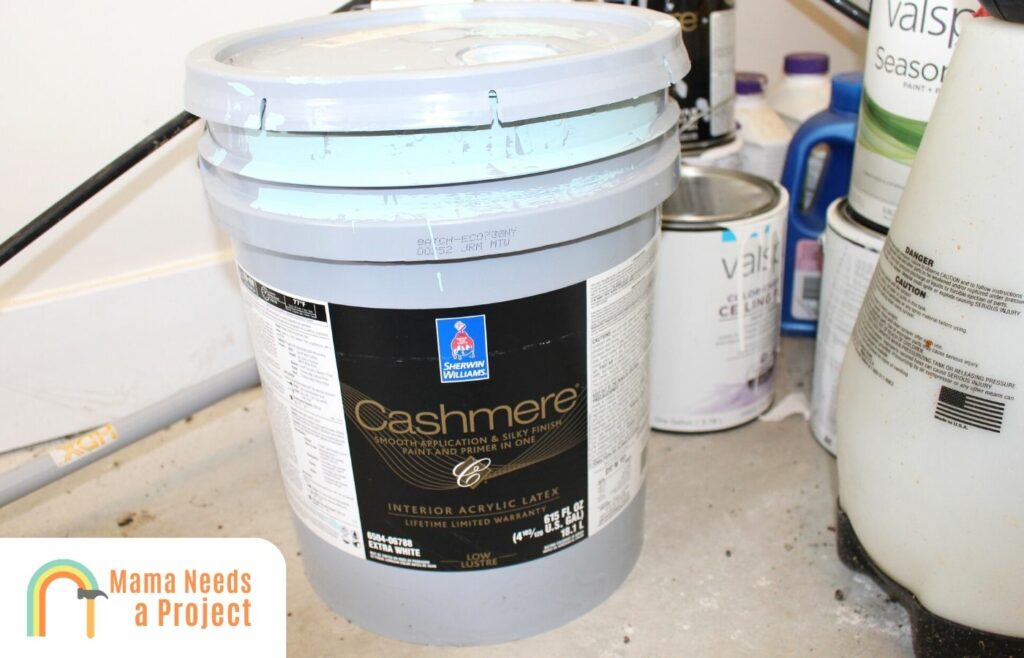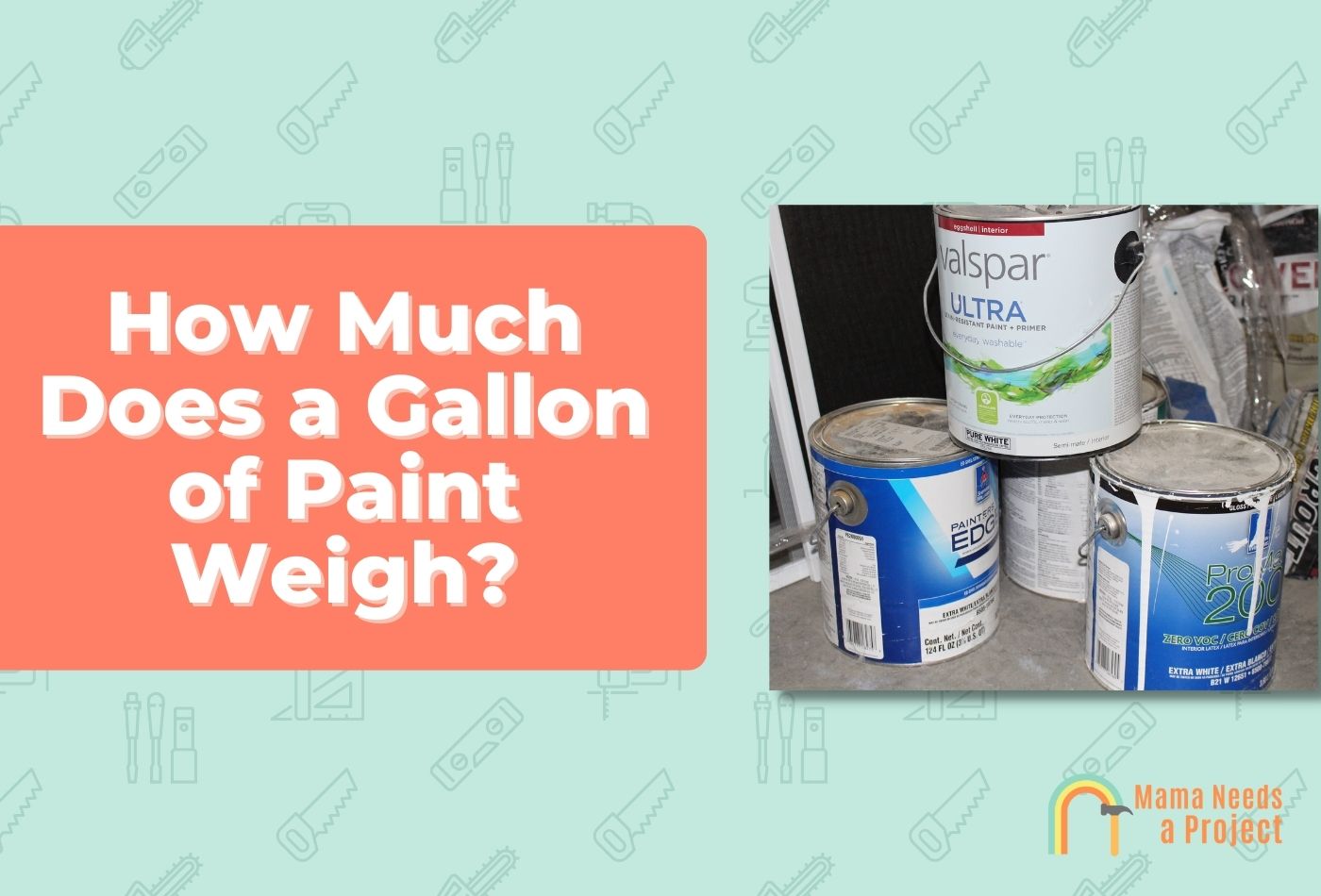How Much Does a Gallon of Paint Weigh? (Quick Answer!)
When browsing the paint aisle at your local hardware store, chances are you won’t consider the weight of a gallon of paint, but you should.
Why? Because paint weight is relevant whether you’re using one gallon or many, and it’s usually considered in relation to price before a large painting job.
Ready to learn how much a gallon of paint weighs? Let’s dig in!
- A gallon of paint usually weighs 6-12 lbs, whether it’s latex, oil-based, acrylic, or enamel paint. In ounces, that’s 96-192 oz, and in kilograms it’s 2.7-5.4 kg.
- The weight of paint is in large part determined by the pigments, resins, solvents, and additives present, and liquid paint weight is always significantly heavier than dry paint weight.
How Much Does a Gallon of Latex Paint Weigh?

Latex paint is the most commonly used paint, ideal for any woodworking and home improvement project.
Otherwise known as “water-based paint” because water is used as the main solvent, latex paints are popular because they’re easy-to-apply, quick-drying, and visually appealing when dry.
Also, they’re not as toxic as other paints, and removing them from brushes, walls, etc. takes no time at all.
A gallon of latex paint usually weighs around 11.3 lbs, and it can cover about 400 square feet.
Therefore, to paint even a small home (inside and outside), you’d need several gallons of latex paint—probably a dozen or so.
Once dry, a gallon of latex paint usually weighs just 4 lbs—less than half its weight in liquid form.
Dry latex paint weighs much less because the water and many of the other components have evaporated.
So if you apply two coats of latex paint, a gallon each, with a gallon of primer that weighs about the same to a 400 square-foot surface, there will be nearly 12 lbs of paint and primer on the surface once everything is dry.
If you have leftover paint, you might be wondering how to store it. Check out my guide to storing paint correctly for more info!
How Much Does a Gallon of Oil Based Paint Weigh?
Oil-based paints are often used for painting furniture and portraits, but they can also be used to coat both indoor and outdoor surfaces.
Oil-based paints are similar to their water-based counterparts in several ways, but it’s the ways in which they’re different that are important.
Oil-based paint is thicker than latex paint because water is absent and instead turpentine or something similar is used.
Since it’s thicker, it takes longer to apply, and it takes longer to dry as well.
It’s also more toxic since it’s loaded with volatile organic compounds (VOC); later paints have these too just not nearly as many.
Yet despite being thicker, a gallon of oil paint usually weighs about the same as latex paint (~12 lbs); sometimes oil-based paint can even be 3-4 lbs lighter.
One things for sure: If you want a rich color that’ll look go over the long term, and you don’t mind spending a bit more, choose oil-based paint.
How Much Does a Gallon of Acrylic Paint Weigh?
Acrylic paint is another water-based paint, but it’s not referred to as such.
In fact, both latex and acrylic paints have acrylic resins in them, but acrylic paints are different because they’re the result of acrylic polymer emulsion; they also have more acrylic resins than latex paints.
Primarily used for arts and craft projects and nail-painting, acrylic paint is about as heavy as latex and oil-based paints.
Just like other paints, one gallon of acrylic paint usually weighs 11-12 lbs.
But this paint is usually sold in liters, and one liter of acrylic paint is about 3 lbs.
Although acrylic paints weigh about the same as oil-based and latex paints, they don’t cover as much area; a gallon of acrylic paint usually covers 250 square feet.
Therefore, if you have a larger painting job, you may want to consider a paint that offers more coverage for a much cheaper price.
How Much Does a Gallon of Enamel Paint Weigh?
Since “enamel paint” is pretty much any paint that has enamel in it, numerous paints can be classified as enamel paints.
Therefore, it’s difficult to determine the exact weight of a gallon of standard enamel paint.
That said, a gallon of the most commonly used “enamel paint”, i.e. the paint that’s used on automobiles, boats, etc., weighs about 11-12 lbs.
A fantastic exterior paint, enamel paint is distinctively glossy and quick-drying, and it’s often used on outdoor furniture and structures because it’s especially weather-resistant.
This paint also resists cracking, peeling, etc. better than other paints – which can come in handy for some projects.
Enamel paints are also used in areas that get extremely hot, since they’re exceptionally heat-resistant.
Lastly, since enamel paint is mostly used to paint cars, trucks, and other vehicles, its weight is important in a few key respects.
After all, the heavier the paint, the more engine power will be needed to thrust the vehicle forward.
(Of course, the weight of paint is negligible in this instance, but the point is valid nonetheless.)
Wondering if you can use exterior paint inside? Check out my guide to using exterior paints inside for more info!
How Much Does a Gallon of Paint Weigh After it Dries?
Dried paint usually weighs a lot less than wet paint. In the case of latex paint, a gallon of this viscous substance in liquid form weighs 11.3 lbs, whereas a 100% dried gallon weighs just 4 lbs.
The reason why so much weight is shed during the drying process is because the solvents evaporate, whether we’re talking about latex or oil-based paints.
Basically, there are three main components in paint: the pigment, the resin, and the solvent.
The pigment is what gives the paint its color, and it also plays a major role in determining how strong the paint will be.
The resin is what causes the paint to stick to the surface, and the solvent is what makes the paint applicable to surfaces.
So when paint is fully cured, i.e. solid through and through, it’s pretty much just pigment and resin—the solvent has evaporated.
How Much Does a Gallon of Paint Weigh in Ounces?
It’s difficult to pinpoint exactly how much a gallon of paint weighs in ounces, since liquids and solids are measured differently.
There are 128 US fluid ounces in 1 imperial gallon, but this fact alone doesn’t help us identify how much a gallon of paint weighs.
Let’s look at it this way: 100% pure water weighs about 8 lbs, and 8 lbs weighs about 120 oz.
Therefore, you have to imagine latex paint, which is mostly water, is around this weight—maybe a little bit more.
And since oil-based and acrylic paints weigh about the same as latex paint, you can only conclude that a gallon of each weighs about 120 oz, too.
At least gallons and ounces are both Imperial units, so you don’t have to worry about metric conversions.
How Much Does a Gallon of Paint Weigh in Pounds?
A gallon of most paints weighs 6-12 pounds, and a variety of factors determine how much a paint ways in both liquid and solid form.
Of course, if you add mineral spirits (paint thinner) before applying paint to a surface, the final dry weight will be heavier, but technically there will be a little more than a gallon of paint (as far as volume goes).
And just because one paint is thicker than another doesn’t mean it’s automatically heavier.
As I’ve pointed out already, latex paint is mostly water, and one would think that because of this it should be lighter than a thick oil paint, but actually both paints weigh about the same.
At the end of the day, the weight of paint doesn’t matter nearly as much as how it looks or is strength.
That said, when it comes to the enamel paints used to coat, boats, airplanes, and other vehicles, weight is important, since it can affect the vehicle’s speed, weight capacity, and buoyancy.
How Much Does a Gallon of Paint Weigh in KG?
If a gallon of most paints weighs 6-12 lbs, then they weigh roughly 2.7-5.4 kg as well. To make this calculation, I had to convert imperial units to metric units.
Frankly, I can’t think of an instance when you’d see a paint container labeled this way, since paint isn’t measured in kilograms but in liters.
Standard Paint Measurements

The most common paint can sizes are pints, quarts, and gallons, but you can get five-gallon bucket, half-pint containers, and other sizes as well.
You’ll also find paint cans that are measured in metric units, usually liters and milliliters.
Generally speaking, if you find a small quantity of paint, i.e. a pint or smaller, that’s relatively expensive compared to other paints of the same quantity, it’s probably better quality overall.
On the other hand, if you find a lot of paint at a low price, it’s probably not the best quality.
Take acrylic paint, for example. One ounce of high-grade acrylic paint can cost anywhere from $2-$4, whereas a gallon (which is technically 120 fluid ounces) can cost just $30.
Factors That Determine the Weight of Paint
Pigments & Coloring
The pigments give paint its color, and they also play a major role in determining how durable the paint is.
Therefore, if certain pigments are used, a paint can resist harsh chemicals, scratches, gouges, and sun fading.
For most paint jobs, multiple coats are required to ensure the color comes through properly.
Solvents
Without solvents, paint wouldn’t be the substance we’re all familiar with. Essentially, the solvents break down the pigments and resins so everything blends together, and they’re the key reason why paint can be spread easily across a surface.
Water is the main solvent in water-based paints, while other paints utilize one synthetic solvent or another.
Resins
Different kinds of resins are used in paints. For example, alkyd resins are used in enamel paints to ensure a glossy finish.
Some protective coating resins are used too, like urethane, epoxy, and polysiloxane.
Again, the main reason why resins are used in paints is so they adhere better to the surfaces they’re applied to; resins also hold the pigment molecules together.
Most water-based paints have acrylic resin in them, whereas dammar, copal and mastic are the resins commonly found in oil-based paints.
Additives
The additives commonly found in paints are penetrol, floetrol, and mildewcide.
Penetrol improves the flow and penetration of oil-based paints, while floetrol does this for water-based products. Mildewcide is used to prevent mildew, of course.
You may also find emulsa bond in paint, as this improves adhesion, and insecticides so harmful bugs aren’t attracted to the paint.
Ground quartz is an additive that gives certain paints a distinct texture, and paints can include fire-retardant additives as well.
Does the Weight of Paint Matter When Painting?
When most people think of paint, its weight isn’t the first thing that comes to mind, but the fact is paint’s weight is significant for a variety of reasons.
For one, weight in part determines how much paint should be applied. After all, if the paint is heavier, at a certain point it’s going to put unnecessary strain on the surface.
Water-based paints, oil-based paints, and most other paint types way about the same, despite their different makeups.
How Much Does an Empty 1 Gallon Paint Can Weigh?
Usually, an empty gallon paint can weighs just under a pound (0.89 lbs).
A paint can’s weight is mostly determined by the material it’s made of.
Most paint cans are made of tin-plated steal, as this material resists corrosion well and will remains strong over the long term.
And since this is the world’s most recycled material, paint cans are pretty cheap. That said, high-grade paint cans can run you $30-$50 dollars, and since these are made of reinforced steel they’re heavier.
Technically, a paint can gets lighter over time as it wears down, but it takes a very long time for this metal to break down naturally.
Final Thoughts
To recap, a gallon of most paints is 6-12 lbs, and a paint’s weight is collectively determined by a variety of factors, the most important being the pigments, resins, and solvents in the paint.
To be specific, a gallon of latex paint usually weighs 11.3, whereas a gallon of oil-based or acrylic paint tends to weigh closer 12 lbs.
Finally, a gallon of liquid paint is always heavier than dry paint, regardless of the paint’s density.

